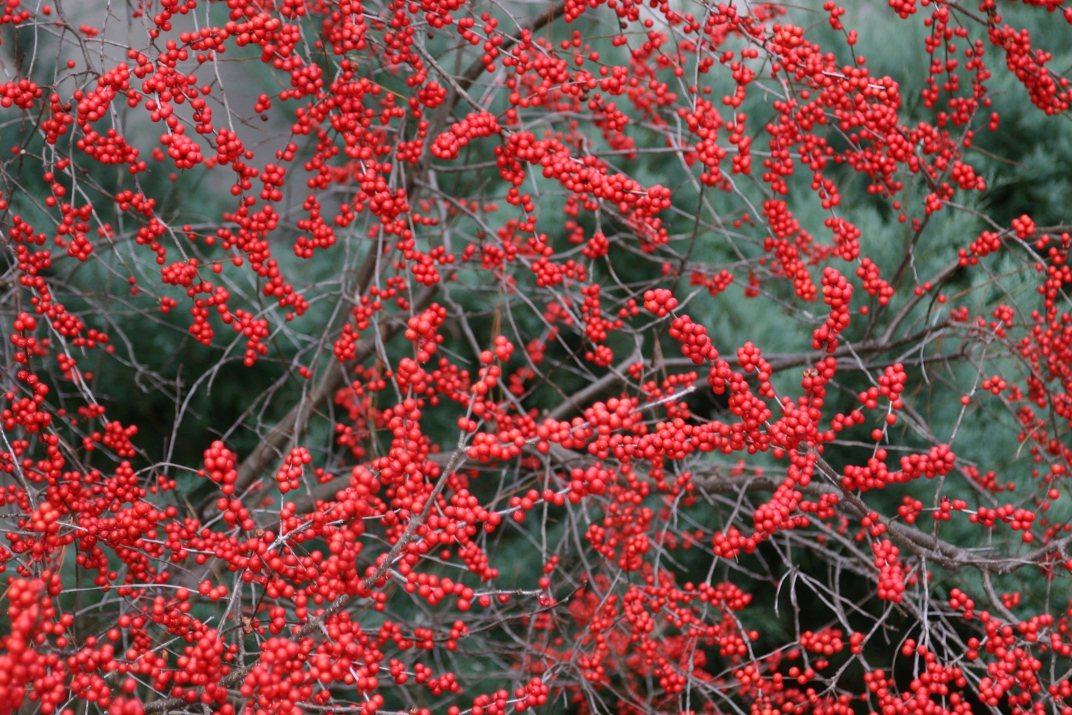Enjoy Winter Garden Color with Berry-Bearing Bushes
 One of the charms of the winter garden is the variety of shrubs and trees that offer colorful fruit, in shades of red, yellow, orange and even white. Among these berried beauties are a great number of hollies (Ilex species and cultivars) including both evergreen and deciduous types. Depending on the selection, hollies can be the size of trees or small shrubs and act as screens, hedges or focal points in the landscape.
One of the charms of the winter garden is the variety of shrubs and trees that offer colorful fruit, in shades of red, yellow, orange and even white. Among these berried beauties are a great number of hollies (Ilex species and cultivars) including both evergreen and deciduous types. Depending on the selection, hollies can be the size of trees or small shrubs and act as screens, hedges or focal points in the landscape.
A diverse group, there are native and exotic types of berry-bearing shrubs and trees; some grow in extremely cold climates, while others are happy in warm regions of the country.
For an effective display in the winter garden, combine berried plants with conifers or deciduous trees with handsome bark. Certain trees such as Crataegus ‘Winter King’ offer striking bark and showy fruits (in this case red). Other shrubs with colorful fruits include cotoneaster, heavenly bamboo, also known as Nandina domestica and pyracantha. Most evergreen types are easy to prune, making them well suited for formal or informal gardens.
Hollies with Colorful Winter Berries
It’s worth noting that most types of hollies have male and female flowers on separate plants. It’s best to have a male and female of the same species to ensure good pollination. Only the females display colorful berries (technically they are known as drupes). Check with your local extension service for a list of which hollies make the best pollinators for your particular selections.
Evergreen Hollies:
- English holly (Ilex aquifolium): This salt tolerant species grows 30 to 50 ft. high. Zones 6 to 7.
- Chinese holly (Ilex cornuta): ‘Burfordii’ is a popular selection; it grows 20 ft. high and wide Zones 6 to 9 or 10.
- Lusterleaf holly (Ilex latifolia): This adaptable holly has large leaves and grows 20 to 25 ft. high. Zones 7 to 9.
- Meserve holly (Ilex x meserveae): These hybrids are well suited for northern gardens. Grow 10 to 15 ft high, and it is easy to prune to a desired size. Zones 5 to 7.
- American holly (Ilex opaca): A popular choice for its classic pyramidal habit, there are many selections of this native including dwarf spreading types. Can grow 40 to 50 ft high and up to 40 ft. wide, depending on selection. Zones 5 to 9.
- Yaupon holly (Ilex vomitoria): This native holly has small leaves and adapts to a wide range of growing conditions. It comes in many forms including weeping, compact and fastigiate. Grows 3 to 20 ft. high, varies on how wide. Zones 7 to 10.
Deciduous Hollies:
- Possumhaw (Ilex decidua): Grows in moist or dry soils, 20 to 30 ft. high and wide with silver-gray stems and red fruit. Zones 5 or 6 to 9.
- Winterberry (Ilex verticillata): Adaptable to wet or dry soil, grows 6 to 10 ft. high and wide, one of the showiest for its fruits. Zones 3 to 9.
Other Berried Shrubs:
- Cotoneaster lacetus: Red fruit, evergreen, grows 6 to 10 ft. high and wide. Zones 6 to 8.
- Nandina domestica: This shrub has red fruits but there is a white fruited selection too. Grows anywhere from 6 to 8 ft. tall depending on cultivar. Zones 6 to 9 or 10.
- Pyracantha species and cultivars: Known as firethorn for the red, orange or yellow fruits. Popular to train as espalier. Grows 6 to 18 ft. high and wide. Zones 5 or 6 to 8.
Erica Glasener is a Networx - https://www.networx.com - writer. Get home & garden ideas like this - https://www.networx.com/article/winter-garden-berries - on Networx.
Looking for a Pro? Call us (866) 441-6648

Landscaping Average Costs
Landscapers Experiences

Hiring A Great Landscaper Was Almost Too Easy, Even Long Distance

Find A Reliable Full Service Crew For No-Fuss Tree Removal



